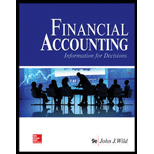
Loose Leaf for Financial Accounting: Information for Decisions
9th Edition
ISBN: 9781260158762
Author: John J Wild
Publisher: McGraw-Hill Education
expand_more
expand_more
format_list_bulleted
Concept explainers
Question
Chapter 1, Problem 3QS
Summary Introduction
Introduction: Fraud triangle is a created to explain the factor related to a fraud committed by a person. There three factors of fraud triangle model as Opportunity, Pressure and rationalization.
To determine: The fraud risk factor (A, B, and C) for the given situations.
Expert Solution & Answer
Want to see the full answer?
Check out a sample textbook solution
Students have asked these similar questions
How much is blakes owners equity?
Q. General Account
Accurate Answer
Chapter 1 Solutions
Loose Leaf for Financial Accounting: Information for Decisions
Ch. 1 - Prob. 1DQCh. 1 - Technology is increasingly used to process...Ch. 1 - Identify four kinds of external users and describe...Ch. 1 - What are at least three questions business owners...Ch. 1 - Prob. 5DQCh. 1 - Describe the internal role of accounting for...Ch. 1 - Identify three types of services typically offered...Ch. 1 - Prob. 8DQCh. 1 - Why is accounting described as a service activity?Ch. 1 - What are some accounting-related professions?
Ch. 1 - Prob. 11DQCh. 1 - Prob. 12DQCh. 1 - What does the concept of objectivity imply for...Ch. 1 - Prob. 14DQCh. 1 - Prob. 15DQCh. 1 - Prob. 16DQCh. 1 - Define (a) assets, (b) liabilities, (c) equity,...Ch. 1 - Prob. 18DQCh. 1 - Prob. 19DQCh. 1 - What do accountants mean by the term revenue?Ch. 1 - Prob. 21DQCh. 1 - Prob. 22DQCh. 1 - Prob. 23DQCh. 1 - Prob. 24DQCh. 1 - Prob. 25DQCh. 1 - Prob. 26DQCh. 1 - Prob. 27DQCh. 1 - Define and explain return on assets.Ch. 1 - Define return and risk. Discuss the trade-off...Ch. 1 - Prob. 30DQCh. 1 - Prob. 31DQCh. 1 - Prob. 32DQCh. 1 - Choose from the following term or phrase a through...Ch. 1 - Prob. 2QSCh. 1 - Prob. 3QSCh. 1 - Identify each of the following terms or phrases as...Ch. 1 - Prob. 5QSCh. 1 - Prob. 6QSCh. 1 - Prob. 7QSCh. 1 - Prob. 8QSCh. 1 - Use Google's December 31. 2016, financial...Ch. 1 - Prob. 10QSCh. 1 - Prob. 11QSCh. 1 - Prob. 12QSCh. 1 - Prob. 13QSCh. 1 - Prob. 14QSCh. 1 - Prob. 15QSCh. 1 - Prob. 16QSCh. 1 - Prob. 17QSCh. 1 - Prob. 1ECh. 1 - Prob. 2ECh. 1 - Prob. 3ECh. 1 - Match each of the numbered descriptions I through...Ch. 1 - Prob. 5ECh. 1 - Enter the letter A through H for the principle or...Ch. 1 - Determine the missing amount from each of the...Ch. 1 - Prob. 10ECh. 1 - Prob. 11ECh. 1 - Prob. 12ECh. 1 - Prob. 13ECh. 1 - Prob. 14ECh. 1 - Prob. 15ECh. 1 - Use the information in Exercise 1-15 to prepare an...Ch. 1 - Prob. 17ECh. 1 - Prob. 18ECh. 1 - Prob. 19ECh. 1 - Prob. 20ECh. 1 - Prob. 21ECh. 1 - Prob. 22ECh. 1 - Prob. 23ECh. 1 - Identify how each of the following separate...Ch. 1 - Prob. 2PSACh. 1 - Prob. 3PSACh. 1 - Prob. 4PSACh. 1 - Prob. 5PSACh. 1 - Prob. 6PSACh. 1 - Gabi Gram started The Gram Co., a new business...Ch. 1 - Prob. 8PSACh. 1 - Sanyu Sony started a new business and completed...Ch. 1 - Prob. 10PSACh. 1 - Prob. 11PSACh. 1 - Prob. 12PSACh. 1 - Prob. 13PSACh. 1 - Prob. 14PSACh. 1 - Prob. 1PSBCh. 1 - Prob. 2PSBCh. 1 - Prob. 3PSBCh. 1 - Prob. 4PSBCh. 1 - Prob. 5PSBCh. 1 - Prob. 6PSBCh. 1 - Prob. 7PSBCh. 1 - Prob. 8PSBCh. 1 - Prob. 9PSBCh. 1 - Prob. 10PSBCh. 1 - Prob. 11PSBCh. 1 - Prob. 12PSBCh. 1 - Prob. 13PSBCh. 1 - Prob. 14PSBCh. 1 - On October 1, 2018, Santana Rey launched a...Ch. 1 - Prob. 1FSACh. 1 - comparative figures ($ millions) for both Apple...Ch. 1 - Prob. 3FSACh. 1 - Prob. 1BTNCh. 1 - Prob. 2BTNCh. 1 - Prob. 4BTNCh. 1 - Prob. 5BTNCh. 1 - Prob. 6BTN
Knowledge Booster
Learn more about
Need a deep-dive on the concept behind this application? Look no further. Learn more about this topic, accounting and related others by exploring similar questions and additional content below.Similar questions
- Sterling Industrial estimated the following annual costs: • Expected annual direct labor hours: 60,500 Expected annual direct labor cost: $850,000 • Expected machine hours: 35,500 • Expected material cost for the year: $1,025,000 • Expected manufacturing overhead: $1,312,000 Determine the overhead allocation rate using direct material cost as the allocation base.arrow_forwardRequire both answerarrow_forwardGet correct answer this general accounting question not use aiarrow_forward
- Hy expert provide answer with calculation accounting questionarrow_forwardStep by step answerarrow_forwardWhich of the following best describes standard costs? A) Costs used as a budget for a single unit of product B) Costs incurred to produce a product C) Costs based on the average of current market values D) Costs used to compare with competitors' pricesarrow_forward
arrow_back_ios
SEE MORE QUESTIONS
arrow_forward_ios
Recommended textbooks for you
 Auditing: A Risk Based-Approach (MindTap Course L...AccountingISBN:9781337619455Author:Karla M Johnstone, Audrey A. Gramling, Larry E. RittenbergPublisher:Cengage Learning
Auditing: A Risk Based-Approach (MindTap Course L...AccountingISBN:9781337619455Author:Karla M Johnstone, Audrey A. Gramling, Larry E. RittenbergPublisher:Cengage Learning Auditing: A Risk Based-Approach to Conducting a Q...AccountingISBN:9781305080577Author:Karla M Johnstone, Audrey A. Gramling, Larry E. RittenbergPublisher:South-Western College Pub
Auditing: A Risk Based-Approach to Conducting a Q...AccountingISBN:9781305080577Author:Karla M Johnstone, Audrey A. Gramling, Larry E. RittenbergPublisher:South-Western College Pub Financial And Managerial AccountingAccountingISBN:9781337902663Author:WARREN, Carl S.Publisher:Cengage Learning,
Financial And Managerial AccountingAccountingISBN:9781337902663Author:WARREN, Carl S.Publisher:Cengage Learning,

Auditing: A Risk Based-Approach (MindTap Course L...
Accounting
ISBN:9781337619455
Author:Karla M Johnstone, Audrey A. Gramling, Larry E. Rittenberg
Publisher:Cengage Learning

Auditing: A Risk Based-Approach to Conducting a Q...
Accounting
ISBN:9781305080577
Author:Karla M Johnstone, Audrey A. Gramling, Larry E. Rittenberg
Publisher:South-Western College Pub

Financial And Managerial Accounting
Accounting
ISBN:9781337902663
Author:WARREN, Carl S.
Publisher:Cengage Learning,